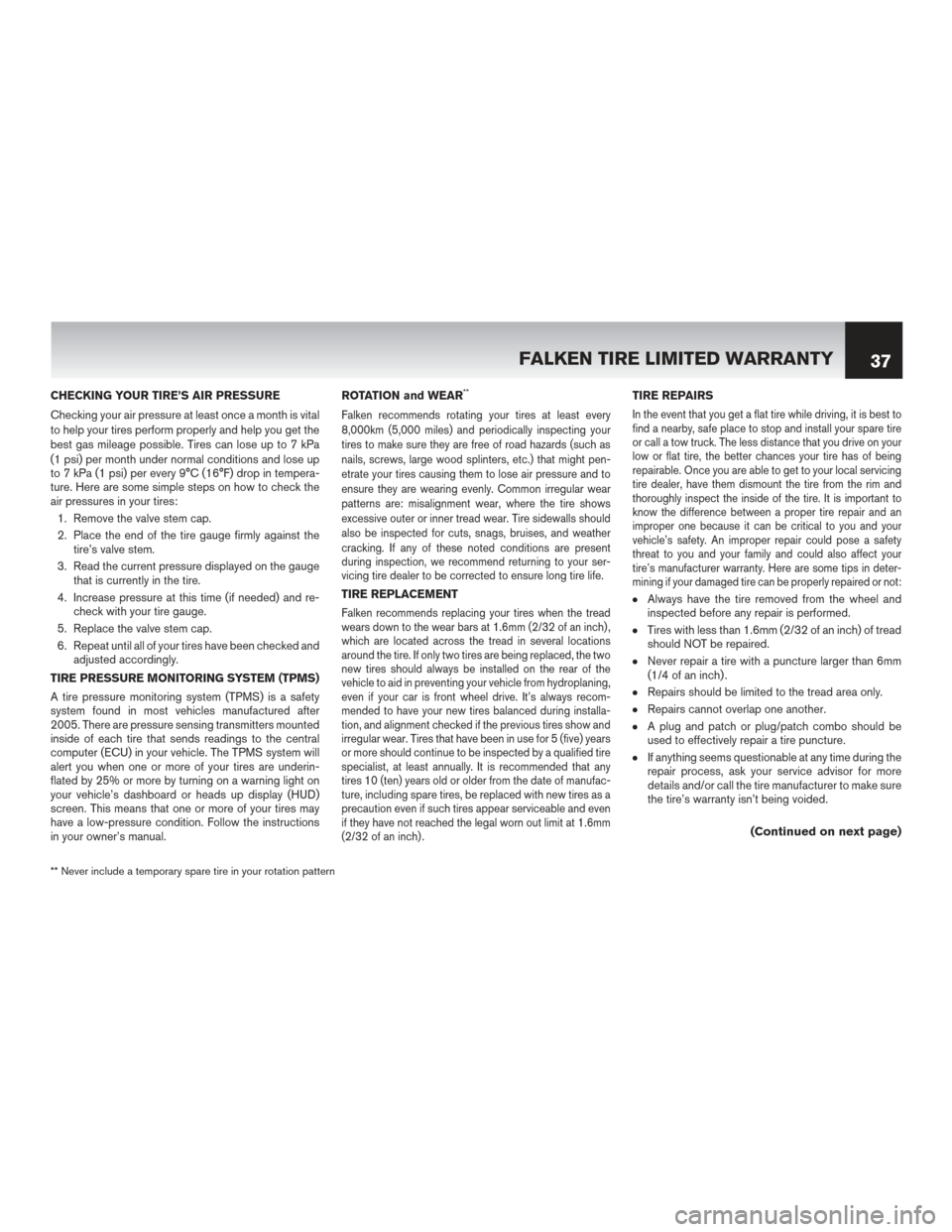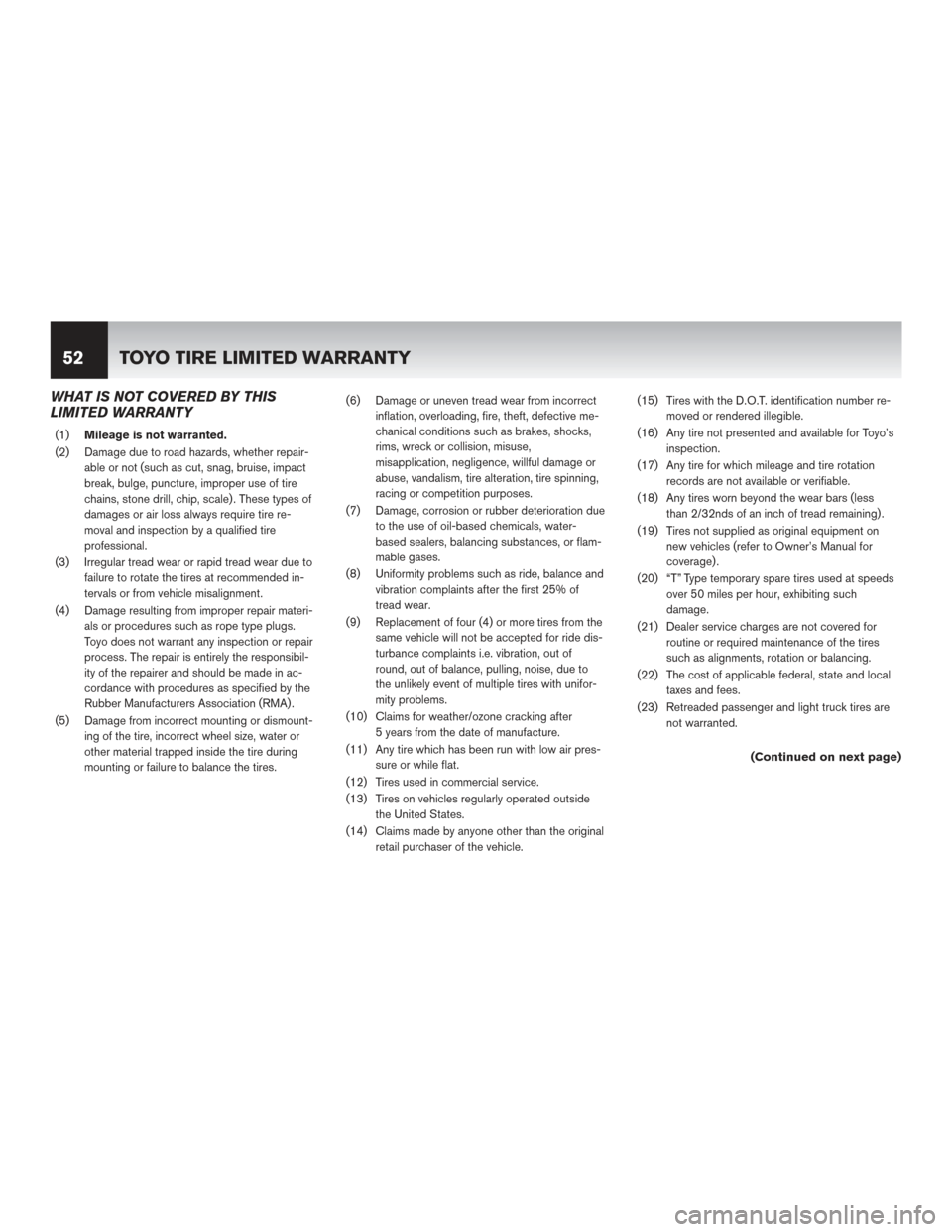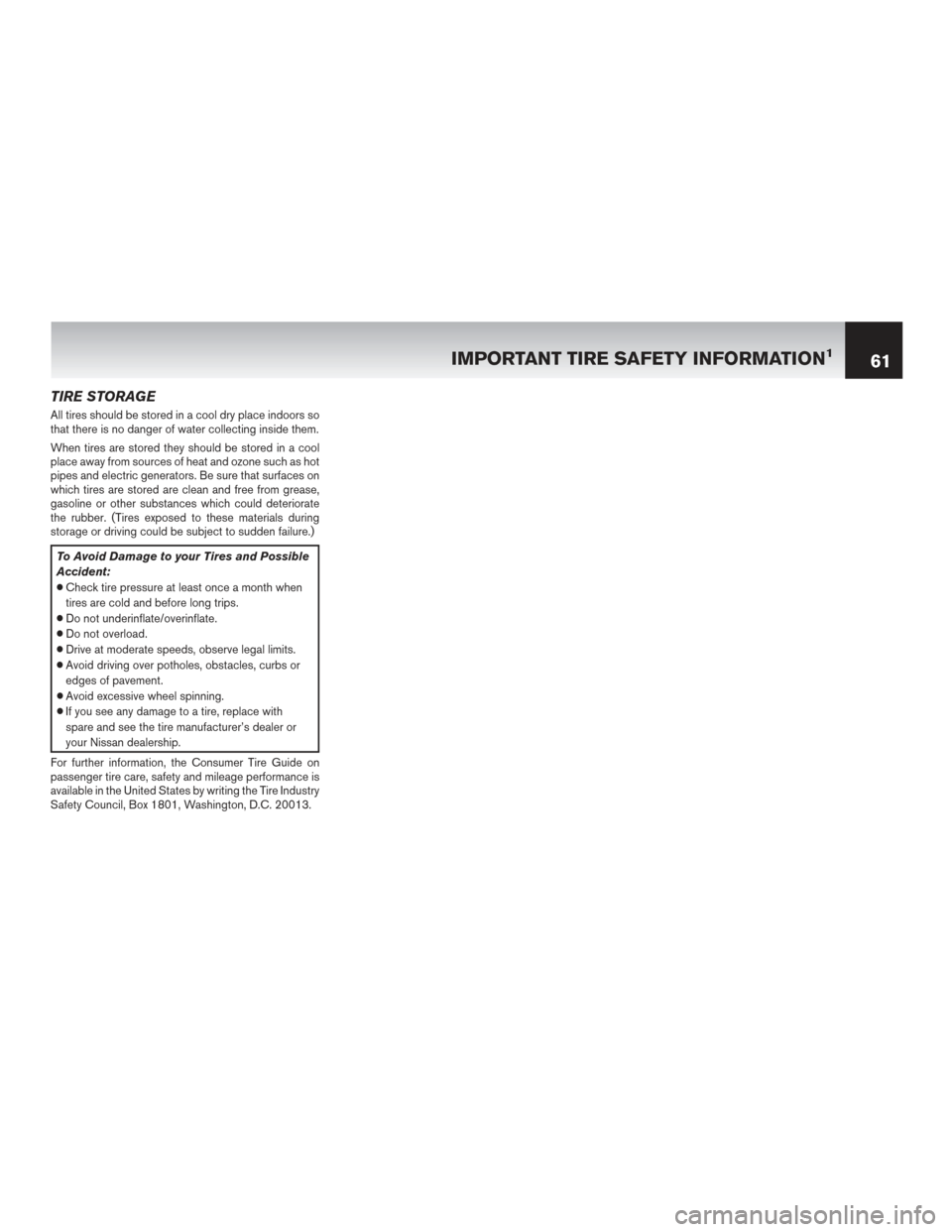2017 NISSAN MURANO HYBRID gas mileage
[x] Cancel search: gas mileagePage 41 of 77

CHECKING YOUR TIRE’S AIR PRESSURE
Checking your air pressure at least once a month is vital
to help your tires perform properly and help you get the
best gas mileage possible. Tires can lose up to 7 kPa
(1 psi) per month under normal conditions and lose up
to 7 kPa (1 psi) per every 9°C (16°F) drop in tempera-
ture. Here are some simple steps on how to check the
air pressures in your tires:1. Remove the valve stem cap.
2. Place the end of the tire gauge firmly against the tire’s valve stem.
3. Read the current pressure displayed on the gauge that is currently in the tire.
4. Increase pressure at this time (if needed) and re- check with your tire gauge.
5. Replace the valve stem cap.
6. Repeat until all of your tires have been checked and adjusted accordingly.
TIRE PRESSURE MONITORING SYSTEM (TPMS)
A tire pressure monitoring system (TPMS) is a safety
system found in most vehicles manufactured after
2005. There are pressure sensing transmitters mounted
inside of each tire that sends readings to the central
computer (ECU) in your vehicle. The TPMS system will
alert you when one or more of your tires are underin-
flated by 25% or more by turning on a warning light on
your vehicle’s dashboard or heads up display (HUD)
screen. This means that one or more of your tires may
have a low-pressure condition. Follow the instructions
in your owner’s manual. ROTATION and WEAR**
Falken recommends rotating your tires at least every
8,000km (5,000 miles) and periodically inspecting your
tires to make sure they are free of road hazards (such as
nails, screws, large wood splinters, etc.) that might pen-
etrate your tires causing them to lose air pressure and to
ensure they are wearing evenly. Common irregular wear
patterns are: misalignment wear, where the tire shows
excessive outer or inner tread wear. Tire sidewalls should
also be inspected for cuts, snags, bruises, and weather
cracking. If any of these noted conditions are present
during inspection, we recommend returning to your ser-
vicing tire dealer to be corrected to ensure long tire life.
TIRE REPLACEMENT
Falken recommends replacing your tires when the tread
wears down to the wear bars at 1.6mm (2/32 of an inch) ,
which are located across the tread in several locations
around the tire. If only two tires are being replaced, the two
new tires should always be installed on the rear of the
vehicle to aid in preventing your vehicle from hydroplaning,
even if your car is front wheel drive. It’s always recom-
mended to have your new tires balanced during installa-
tion, and alignment checked if the previous tires show and
irregular wear. Tires that have been in use for 5 (five) years
or more should continue to be inspected by a qualified tire
specialist, at least annually. It is recommended that any
tires 10 (ten) years old or older from the date of manufac-
ture, including spare tires, be replaced with new tires as a
precaution even if such tires appear serviceable and even
if they have not reached the legal worn out limit at 1.6mm
(2/32 of an inch) .
TIRE REPAIRS
In the event that you get a flat tire while driving, it is best to
find a nearby, safe place to stop and install your spare tire
or call a tow truck. The less distance that you drive on your
low or flat tire, the better chances your tire has of being
repairable. Once you are able to get to your local servicing
tire dealer, have them dismount the tire from the rim and
thoroughly inspect the inside of the tire. It is important to
know the difference between a proper tire repair and an
improper one because it can be critical to you and your
vehicle’s safety. An improper repair could pose a safety
threat to you and your family and could also affect your
tire’s manufacturer warranty. Here are some tips in deter-
mining if your damaged tire can be properly repaired or not:
●Always have the tire removed from the wheel and
inspected before any repair is performed.
●Tires with less than 1.6mm (2/32 of an inch) of tread
should NOT be repaired.
●Never repair a tire with a puncture larger than 6mm
(1/4 of an inch) .
●Repairs should be limited to the tread area only.
●Repairs cannot overlap one another.
●A plug and patch or plug/patch combo should be
used to effectively repair a tire puncture.
●If anything seems questionable at any time during the
repair process, ask your service advisor for more
details and/or call the tire manufacturer to make sure
the tire’s warranty isn’t being voided.
(Continued on next page)
** Never include a temporary spare tire in your rotation pattern
FALKEN TIRE LIMITED WARRANTY 37
Page 56 of 77

WHAT IS NOT COVERED BY THIS
LIMITED WARRANTY
(1)Mileage is not warranted.
(2) Damage due to road hazards, whether repair- able or not (such as cut, snag, bruise, impact
break, bulge, puncture, improper use of tire
chains, stone drill, chip, scale) . These types of
damages or air loss always require tire re-
moval and inspection by a qualified tire
professional.
(3) Irregular tread wear or rapid tread wear due to failure to rotate the tires at recommended in-
tervals or from vehicle misalignment.
(4) Damage resulting from improper repair materi- als or procedures such as rope type plugs.
Toyo does not warrant any inspection or repair
process. The repair is entirely the responsibil-
ity of the repairer and should be made in ac-
cordance with procedures as specified by the
Rubber Manufacturers Association (RMA) .
(5) Damage from incorrect mounting or dismount- ing of the tire, incorrect wheel size, water or
other material trapped inside the tire during
mounting or failure to balance the tires. (6) Damage or uneven tread wear from incorrect
inflation, overloading, fire, theft, defective me-
chanical conditions such as brakes, shocks,
rims, wreck or collision, misuse,
misapplication, negligence, willful damage or
abuse, vandalism, tire alteration, tire spinning,
racing or competition purposes.
(7) Damage, corrosion or rubber deterioration due to the use of oil-based chemicals, water-
based sealers, balancing substances, or flam-
mable gases.
(8) Uniformity problems such as ride, balance and vibration complaints after the first 25% of
tread wear.
(9) Replacement of four (4) or more tires from the same vehicle will not be accepted for ride dis-
turbance complaints i.e. vibration, out of
round, out of balance, pulling, noise, due to
the unlikely event of multiple tires with unifor-
mity problems.
(10) Claims for weather/ozone cracking after 5 years from the date of manufacture.
(11) Any tire which has been run with low air pres- sure or while flat.
(12) Tires used in commercial service.
(13) Tires on vehicles regularly operated outside the United States.
(14) Claims made by anyone other than the original retail purchaser of the vehicle. (15) Tires with the D.O.T. identification number re-
moved or rendered illegible.
(16) Any tire not presented and available for Toyo’s inspection.
(17) Any tire for which mileage and tire rotation records are not available or verifiable.
(18) Any tires worn beyond the wear bars (less than 2/32nds of an inch of tread remaining) .
(19) Tires not supplied as original equipment on new vehicles (refer to Owner’s Manual for
coverage) .
(20) “T” Type temporary spare tires used at speeds over 50 miles per hour, exhibiting such
damage.
(21) Dealer service charges are not covered for routine or required maintenance of the tires
such as alignments, rotation or balancing.
(22) The cost of applicable federal, state and local taxes and fees.
(23) Retreaded passenger and light truck tires are not warranted.
(Continued on next page)
52 TOYO TIRE LIMITED WARRANTY
Page 65 of 77

TIRE STORAGE
All tires should be stored in a cool dry place indoors so
that there is no danger of water collecting inside them.
When tires are stored they should be stored in a cool
place away from sources of heat and ozone such as hot
pipes and electric generators. Be sure that surfaces on
which tires are stored are clean and free from grease,
gasoline or other substances which could deteriorate
the rubber. (Tires exposed to these materials during
storage or driving could be subject to sudden failure.)
To Avoid Damage to your Tires and Possible
Accident:
●Check tire pressure at least once a month when
tires are cold and before long trips.
● Do not underinflate/overinflate.
● Do not overload.
● Drive at moderate speeds, observe legal limits.
● Avoid driving over potholes, obstacles, curbs or
edges of pavement.
● Avoid excessive wheel spinning.
● If you see any damage to a tire, replace with
spare and see the tire manufacturer’s dealer or
your Nissan dealership.
For further information, the Consumer Tire Guide on
passenger tire care, safety and mileage performance is
available in the United States by writing the Tire Industry
Safety Council, Box 1801, Washington, D.C. 20013.
IMPORTANT TIRE SAFETY INFORMATION161